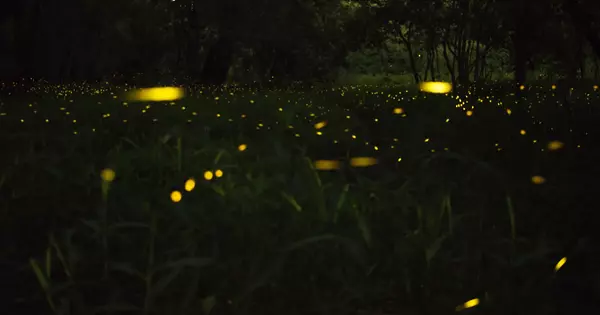Fireflies, also known as lightning bugs, are beetles. The larval stage (1-2 years) is where they spend the majority of their life, feeding on snails, worms, and smaller insects in the leaf litter on the forest floor. They only live for about 3-4 weeks after maturing into adults, and many do not feed.
The flash patterns of fireflies are part of their mating display. Each species has a distinct pattern that aids male and female individuals in recognizing and locating one another. Most species emit a greenish-yellow light, while others emit a blue or white light. Males typically flash while flying, and females, which are usually stationary, respond by flashing.
A new study by mathematicians demonstrates how neuroscience-inspired math can describe how swarms of these unique insects coordinate their light show, capturing key details about how they behave in the wild. At the right time of year, you can see one of nature’s greatest light shows: swarms of fireflies that synchronize their flashes like strings of Christmas lights in the dark in Pennsylvania’s Cook State Forest.
A new study by Pitt mathematicians demonstrates how neuroscience-inspired math can describe how swarms of these unique insects coordinate their light show, capturing key details about how they behave in the wild.
Synchrony is important for a lot of things, good and bad. Physicists, mathematicians, we’re all interested in synchronization.
Bard Ermentrout
“This firefly has a rapid sequence of flashes, followed by a long pause before the next burst,” said Jonathan Rubin, professor, and chair of the Department of Mathematics in the Kenneth P. Dietrich School of Arts and Sciences. “We knew a good modeling framework that could capture a lot of the features, and we wanted to see how far we could push it.”
Male fireflies emit a glow from their abdomens to attract potential mates, and they send out blinking patterns in the dark to attract females of their own species. Photinus carolinus synchronous fireflies go even further, coordinating their blinking across entire swarms. It’s a rare trait – there are only a handful of such species in North America and the striking lights they produce draw crowds to locations where the insects are known to gather.
They’ve also attracted the interest of mathematicians seeking to understand how they synchronize their blinks. It’s just one example of how synchronization can evolve from randomness, a process that has intrigued mathematicians for centuries. One famous example from the 1600s showed that pendulum clocks hung next to one another synchronize through vibrations that travel through the wall, and the same branch of math can be used to describe everything from the action of intestines to audience members clapping.

“Synchrony is important for a lot of things, good and bad,” said co-author Bard Ermentrout, distinguished professor of mathematics in the Dietrich School. “Physicists, mathematicians, we’re all interested in synchronization.”
To crack the fireflies’ light show, the Pitt team used a more complex model called an “elliptic burster” that’s used to describe the behavior of brain cells. The duo, along with then-undergrad Madeline McCrea (A&S ’22) published details of their model in the Journal of the Royal Society Interface.
The first step was to simulate a single firefly’s blinks, then expand to a pair to see how their flashing rates matched. The team then moved on to a larger swarm of simulated insects to investigate how the number, distance, and flying speed affect the resulting blinks.
They discovered that varying the distances at which each firefly could “see” and respond to one another changed the insects’ light show: by tweaking the parameters, they could produce patterns of blinks that looked like ripples or spirals.
The findings corroborate several recent observations about real-life synchronous fireflies, such as the fact that individual fireflies are inconsistent while groups flash more frequently, and that when new fireflies join the swarm, they’re already perfectly in time.
“It captured a lot of the finer details that they saw in the biology, which was cool,” said Ermentrout. “We didn’t expect that.”
The math also makes some predictions that could help with firefly research, such as how light pollution and time of day affect the patterns produced by fireflies by affecting how well they can see each other’s blinks. As an undergraduate, McCrea worked on the research with the help of the department’s Painter Fellowship, which provided her with funding to work on the project over the summer. “She was awesome working on this project, and she was very persistent,” Rubin said.
The team is the first to use this specific brain-cell framework to model fireflies, which are being studied by several different research groups using various types of math. “It’s more of a wild west research topic,” Ermentrout explained. “It’s early, and who knows where things will go from here?”
Ermentrout and Rubin are also hoping that the math will pique the interest of those who are drawn to the glow of fireflies. During the course of this project, Rubin decided to visit Cook State Forest to see if he could spot his research subjects in person.
“I convinced my wife to go on a two-day trip right in the middle of the season,” he explained. “We didn’t see any synchronized activity, but there were a lot of fireflies around us. It was incredible.”





